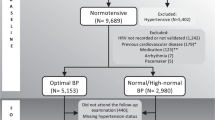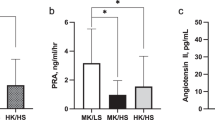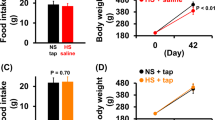Abstract
Background/Objectives:
As salt preference is known to cause hypertension (HTN), the present study was conducted to assess the impact of preference for salt on sympathovagal imbalance in prehypertensives by spectral analysis of heart rate variability (HRV).
Subjects/Methods:
Body mass index (BMI), basal heart rate, blood pressure (BP), rate pressure product and spectral indices of HRV such as total power (TP), normalized low frequency power (LFnu), normalized high frequency power (HFnu), ratio of low frequency power to high frequency power (LF-HF ratio), mean heart rate, square root of the mean squared differences of successive normal to normal (NN) intervals, the number of interval differences of successive NN intervals >50 ms (NN50) and the proportion derived by dividing NN50 by the total number of NN intervals were assessed in 555 subjects divided into four groups: Group 1, normotensives no-salt-preference subjects (n=260); Group 2, normotensives salt-preference subjects (n=185); Group 3, prehypertensives no-salt-preference subjects (n=25); and Group 4, prehypertensives salt-preference subjects (n=89). Sympathovagal balance was analyzed and contribution of individual factor to sympathovagal imbalance was assessed by regression analysis.
Results:
LFnu was significantly increased (P=0.009), whereas TP and HFnu were significantly decreased (P=0.024 and 0.007, respectively) in the salt-preference groups compared with the no-salt-preference groups. LF-HF ratio, the sensitive indicator of sympathovagal balance, was significantly increased (P<0.0001) in salt-preference subjects compared with no-salt-preference subjects. In regression analysis, the link of LF-HF ratio to HTN status was found to be more prominent in the salt-preference group (P=0.000) compared with the no-salt-preference group (P=0.004). BMI had no significant contribution (P=0.818) to LF-HF ratio in salt-preference subjects.
Conclusions:
Salt preference is associated with sympathovagal imbalance caused by sympathetic overactivity and vagal withdrawal. Sympathovagal imbalance is more intense in salt-preferring prehypertensives compared with salt-preferring normotensives. Sympathovagal imbalance in salt-preferring subjects is independent of BMI. Thus, salt-preferring subjects should be encouraged to restrict salt intake to maintain their sympathovagal balance and BP homeostasis.
This is a preview of subscription content, access via your institution
Access options
Subscribe to this journal
Receive 12 print issues and online access
$259.00 per year
only $21.58 per issue
Buy this article
- Purchase on Springer Link
- Instant access to full article PDF
Prices may be subject to local taxes which are calculated during checkout

Similar content being viewed by others
References
Schechter PJ, Horwitz D, Henkin RI . Salt preference in patients with untreated and treated essential hypertension. Am J Med Sci 1974; 267: 320–326.
Contreras RJ . Salt taste and disease. Am J Clin Nutr 1978; 31: 1088–1097.
Ferrell F, Gray SD . Longitudinal study of salt preferences in normotensive and hypertensive rats. Hypertension 1985; 7: 326–332.
Mattes RD . Salt taste and hypertension: a critical review of the literature. J Chronic Dis 1984; 37: 195–208.
Ando K, Fujita M . Reactive oxygen species and the central nervous system in salt-sensitive hypertension: possible relationship with obesity-induced hypertension. Clin Exp Pharmacol Physiol 2012; 39: 111–116.
Babkin AP, Gladkikh VV, Pershukov IV . Salt sensitivity in patients with arterial hypertension. Kardiologiia 2010; 50: 57–62.
Yatabe MS, Yatabe J, Yoneda M, Watanabe T, Otsuki M, Felder RA et al. Salt sensitivity is associated with insulin resistance, sympathetic overactivity, and decreased suppression of circulating renin activity in lean patients with essential hypertension. Am J Clin Nutr 2010; 92: 77–82.
Erdogan D, Caliskan M, Yildirim I, Gullu H, Baycan S, Ciftci O et al. Effects of normal blood pressure, prehypertension and hypertension on left ventricular diastolic function and aortic elastic properties. Blood Press 2007; 16: 114–121.
MacEneaney OJ, DeSouza CA, Weil BR, Kushner EJ, Van Guilder GP, Mestek ML et al. Prehypertension and endothelial progenitor cell function. J Hum Hypertens 2011; 25: 57–62.
Maule S, Rabbia F, Perni V, Tosello F, Bisbocci D, Mulatero P et al. Prolonged QT interval and reduced heart rate variability in patients with uncomplicated essential hypertension. Hypertens Res 2008; 31: 2003–2010.
Pagani M, Lucini D . Autonomic dysregulation in essential hypertension: insight from heart rate and arterial pressure variability. Auton Neurosci 2001; 90: 76–82.
Malpas SC . Sympathetic nervous system overactivity and its role in the development of cardiovascular disease. Physiol Rev 2010; 90: 513–557.
Bruno RM, Sudano I, Ghiadoni L, Masi L, Taddei S . Interactions between sympathetic nervous system and endogenous endothelin in patients with essential hypertension. Hypertension 2011; 57: 79–84.
Kotsis V, Stabouli S, Papakatsika S, Rizos Z, Parati G . Mechanisms of obesity-induced hypertension. Hypertens Res 2010; 33: 386–393.
Pal GK, Adithan C, Dutta TK, Amudharaj D, Pravati P, Nandan PG et al. Assessment of sympathovagal imbalance by spectral analysis of heart rate variability in prehypertensive and hypertensive patients in Indian population. Clin Exp Hypertens 2011; 33: 478–483.
Pal GK, Amudharaj D, Pal P, Saranya K, Lalita V, Gopinath M et al. Study of sympathovagal imbalance by spectral analysis of heart rate variability in young prehypertensives. Ind J Physiol Pharmacol 2011; 55: 357–363.
Pal GK, Pal P, Nivedita N, Lalitha V, Amudharaj D, Dutta TK et al. Increased vascular tone due to sympathovagal imbalance in normotensive and prehypertensive offspring of hypertensive parents. International Angiol 2012; 31: 340–347.
Pal GK, Pal P, Nanda N, Lalita V, Dutta TK, Adithan C . Effect of gender on sympathovagal imbalance in prehypertensives. Clin Exp Hypertens 2012; 34: 31–37.
Pal GK, Pal P, Nivedita N, Lalitha V, Dutta TK, Adithan C . Sympathovagal imbalance in young prehypertensives: importance of male-female difference. Am J Med Sci 2012; 345: 10–17.
Pal GK, Pravati Pal, Nivedita N, Lalitha V, Dutta TK, Adithan C . Sympathovagal imbalance in prehypertensive offspring of two parents versus one parent hypertensive. Int J Hypertens 2011, Article ID 263170, 8 pages; doi:10.4061/2011/263170.
Foulds HJ, Bredin SS, Warburton DE . The relationship between obesity and hypertension across different ethnicities. J Hypertens 2012; 30: 359–367.
Malliani A . Heart rate variability: from bench to bedside. Eur J Int Med 2005; 16: 12–20.
National Heart, Lung and Blood Institute. Classification of blood pressure. In: The seventh report of the joint national committee on prevention, detection, evaluation, and treatment of high blood pressure. National High Blood Pressure Education Program; NIH Publication: USA, 12 2004.
Sacknoff DM, Gleim GW, Stachenfeld N, Coplan NL . Effect of athletic training on heart rate variability. Am Heart J 1994; 127: 1275–1278.
Task force of the European Society of Cardiology and the North American society of Pacing and Electrophysiology. Heart rate variability. Standard and measurement, physiological interpretation and clinical use. Circulation 1996; 93: 1043–1065.
Peoples GE, McLennan PL, Howe PR, Groeller H . Fish oil reduces heart rate and oxygen consumption during exercise. J Cardiovasc Pharmacol 2008; 52: 540–547.
Mathias CJ, Bannister R . Investigation of autonomic disorders. In: Bannister RS, Mathias CJ, (eds). Autonomic Failure: A Textbook of Clinical Disorders of Autonomic Nervous System 3rd edn Oxford University Press: Oxford, UK, 1999, pp 169–195.
Thayer JF, Yamamoto SS, Brosschot JF . The relationship of autonomic imbalance, heart rate variability and cardiovascular disease risk factors. Int J Cardiol 2010; 141: 122–131.
Palatini P . Elevated heart rate as a predictor of increased cardiovascular morbidity. J Hypertens 1999; 17: S3–S10.
Buchholz K, Schächinger H, Wagner M, Sharma AM, Deter HC . Reduced vagal activity in salt-sensitive subjects during mental challenge. Am J Hypertens 2003; 16: 531–536.
Strazzullo P, Barbato A, Vuotto P, Galletti F . Relationships between salt sensitivity of blood pressure and sympathetic nervous system activity: a short review of evidence. Clin Exp Hypertens 2001; 23: 25–33.
Luft FC, Weinberger MH . Heterogenous responses to changes in dietary salt intake: the salt-sensitivity paradigm. Am J Clin Nutr 1997; 65: 612S–617S.
Carlson SH, Shelton J, White CR, Wyss JM . Elevated sympathetic activity contributes to hypertension and salt sensitivity in diabetic obese Zucker rats. Hypertension 2000; 35: 403–408.
Fujita T, Henry WL, Bartter FC, Lake CR, Delea CS . Factors influencing blood pressure in salt-sensitive patients with hypertension. Am J Physiol 1980; 69: 334–344.
Lambert E, Sari CI, Dawood T, Nguyen J, McGrane M, Eikelis N et al. Sympathetic nervous system activity is associated with obesity-induced subclinical organ damage in young adults. Hypertension 2010; 56: 351–358.
Dangardt F, Volkmann R, Chen Y, Osika W, Mårild S, Friberg P . Reduced cardiac vagal activity in obese children and adolescents. Clin Physiol Funct Imaging 2011; 31: 108–113.
Pal GK, Adithan C, Ananthanarayanan PH, Dutta TK, Pal P, Nanda N et al. Body mass index contributes to sympathovagal imbalance in prehypertensives. BMC Cardiovasc Disord 2012; 12: 54.
Sechi LA . Mechanisms of insulin resistance in rat models of hypertension and their relationships with salt sensitivity. J Hypertens 1999; 17: 1229–1237.
Gudbjornsdottir S, Lonnroth P, Sverrisdottir YB, Wallin BG, Elam M . Sympathetic nerve activity and insulin in obese normotensive and hypertensive men. Hypertension 1996; 27: 276–280.
Pal GK, Pal P, Nanda N, Amudharaj D, Adithan C . Cardiovascular dysfunctions and sympathovagal imbalance in hypertension and prehypertension: physiological perspectives. Future Cardiol 2013; 9: 53–69.
Pal GK Blood pressure and its regulation. In: Textbook of Medical Physiology, 2nd edn 2010: Ahuja Publishing House: New Delhi, India. pp 646–660.
Beauchamp GK, Engelman K . High salt intake: sensory and behavioral factors. Hypertension 1991; 17: I176–1781.
Weinberger MH, Fineberg NS, Fineberg SE, Weinberger M . Salt sensitivity, pulse pressure and death in normal and hypertensive humans. Hypertension 2001; 37: 429–432.
Kerstens MN, van der Kleij FG, Boonstra AH, Sluiter WJ, Koerts J, Navis G et al. Salt loading affects cortisol metabolism in normotensive subjects: relationships with salt sensitivity. J Clin Endocrinol Metab 2003; 88: 4180–4185.
Weber CS, Thayer JF, Rudat M, Sharma AM, Perschel FH, Buchholz K et al. Salt-sensitive men show reduced heart rate variability, lower norepinephrine and enhanced cortisol during mental stress. J Hum Hypertens 2008; 22: 423–431.
Chamarthi B, Williams JS, Williams GH . A mechanism for salt-sensitive hypertension: abnormal dietary sodium-mediated vascular response to angiotensin-II. J Hypertens 2010; 28: 1020–1026.
Machura K, Neubauer B, Steppan D, Kettl R, Groβ A, Kurtz A . Role of blood pressure in mediating the influence of salt intake on renin expression in the kidney. Am J Physiol Renal Physiol 2012; 302: F1278–F1285.
Rao AD, Sun B, Saxena A, Hopkins PN, Jeunemaitre X, Brown NJ et al. Polymorphisms in the serum- and glucocorticoid-inducible kinase 1 gene are associated with blood pressure and renin response to dietary salt intake. J Hum Hypertens 2012; 27: 176–180.
Author information
Authors and Affiliations
Corresponding author
Ethics declarations
Competing interests
The authors declare no conflict of interest.
Rights and permissions
About this article
Cite this article
Pal, G., Adithan, C., Dutta, T. et al. Preference for salt contributes to sympathovagal imbalance in the genesis of prehypertension. Eur J Clin Nutr 67, 586–591 (2013). https://doi.org/10.1038/ejcn.2013.64
Received:
Revised:
Accepted:
Published:
Issue Date:
DOI: https://doi.org/10.1038/ejcn.2013.64
Keywords
This article is cited by
-
Association between urinary sodium excretion and uric acid, and its interaction on the risk of prehypertension among Chinese young adults
Scientific Reports (2018)
-
Associations between liking for fat, sweet or salt and obesity risk in French adults: a prospective cohort study
International Journal of Behavioral Nutrition and Physical Activity (2016)
-
Associations between weight status and liking scores for sweet, salt and fat according to the gender in adults (The Nutrinet-Santé study)
European Journal of Clinical Nutrition (2015)



